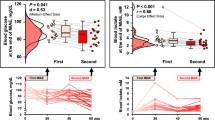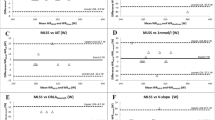Summary
The purpose of this investigation was to assess the effect of endurance training based upon the intensity as determined by the arterial blood lactate concentration (LA). Seven healthy male college students performed endurance training on a Monark bicycle ergometer for 15 min on 3 days/week for 8 weeks, at an intensity corresponding to 4 mmol·l−1 arterial blood LA determined during an incremental exercise test (25 watts increment every minute on a bicycle at 50 rpm). Another six male students served as the control group.
To assess the training effect, both an incremental exercise test and a submaximal exercise test were performed before and after the endurance training. In the incremental exercise test,\(\dot VO_{2max} ,\dot V_E\) at\(\dot VO_{2max}\), anaerobic threshold (AT), and the onset of respiratory compensation for metabolic acidosis (RCMA) were measured. AT was determined as the point at which arterial LA rose above the resting value, and RCMA was determined as the point at which Paco2 decreased during the incremental exercise test.
After training, AT increased significantly (37% increment expressed in\(\dot VO_2\),p<0.05). There was a significant increase (p<0.05) in RCMA (17%) and\(\dot VO_{2max}\) (14%). This training decreased\(\dot VO_2\) (4%),\(\dot V_E\) (15%), heart rate (10%), respiratory exchange ratio (5%), and LA (23%) significantly (p<0.05) during the submaximal exercise test after training. On the other hand, there were no significant changes in the control group through the period when the training group performed their training.
These results showed that the endurance training intensity corresponding to 4 mmol·l−1 arterial blood LA was effective for the improvement in AT as well as\(\dot VO_{2max}\). It is suggested that the present training regimen could delay the onset of anaerobic glycolysis, thus shifting AT to the higher workload and decreasing LA at a given submaximal exercise after training.
Similar content being viewed by others
References
Andersen P, Henriksson J (1977) Capillary supply of the quadriceps femoris muscle of man: Adaptive response to exercise. J Physiol 270: 677–690
Davis JA, Frank MH, Whipp BJ, Wasserman K (1979) Anaerobic threshold alterations caused by endurance training in middle-aged men. J Appl Physiol Respirat Environ Exercise Physiol 46: 1039–1046
Ekblom B (1969) Effect of physical training on oxygen transport system in man. Acta Physiol Scand [Suppl 328]
Gollnick PD, Hermansen L (1973) Biochemical adaptations to exercuse: Anaerobic metabolism. In: Wilmore JH (ed) Exercise and sport sciences reviews, vol 1, 1st edn. Academic Press, New York, pp 1–43
Gollnick PD, Amstrong RB, Saltin B, Saubert IV CW, Sembrowich WL, Shephard RE (1973) Effect of training on enzyme activity and fiber composition of human skeletal muscle. J Appl Physiol 34: 107–111
Henriksson J (1977) Training induced adaptation of skeletal muscle and metabolism during submaximal exercise. J Physiol 270: 661–675
Henriksson J, Reitman JS (1977) Time course of changes in human skeletal muscle succinate dehydrogenase and cytochrome oxidase activities and maximal oxygen uptake with physical activity and inactivity. Acta Physiol Scand 99: 91–97
Ivy JL, Withers RT, Van Handel RJ, Elger DH, Costill DL (1980) Muscle respiratory capacity and fiber type as determinants of the lactate threshold. J Appl Physiol Respirat Environ Exercise Physiol 48: 523–527
Katch V, Weltman A, Sady S, Freedson P (1978) Validity of the relative percent concept for equating training intensity. Eur J Appl Physiol 39: 219–227
Kiessling K-H, Piehl K, Lundquist C-G (1971) Effect of physical training on ultrastructural features in human skeletal muscle. In: Pernow B, Saltin B (eds) Muscle metabolism during exercise, 1st edn. Plenum Press, New York, pp 97–101
Kindermann W, Simon G, Keul J (1979) The significance of the aerobic-anaerobic transition for the determination of work load intensities during endurance training. Eur J Appl Physiol 42: 25–34
Lehninger AL (1975) Biochemistry: The molecular basis of cell structure and function, 2nd edn. Worth Publishers Inc, New York, pp 363–441
Rusko H, Rahkila P, Karvinen E (1980) Anaerobic threshold, skeletal muscle enzymes and fiber composition in young female cross-country skiers. Acta Physiol Scand 108: 263–268
Saltin B, Hartley LH, Kilbom A, åstrand I (1969) Physical training in sedentary middle-aged and older men. II. Oxygen uptake, heart rate, and blood lactate concentration at submaximal and maximal exercise. Scand J Clin Lab Invest 24: 323–334
Senay LC, Kok R (1977) Effects of training and heat acclimatization on blood plasma contents of exercising men. J Appl Physiol Respirat Environ Exercise Physiol 43: 591–599
Sjödin B (1981) Training effects on onset of blood lactate accumulation and muscle enzyme activities. Med Sci Sports Exerc 13: 114
Wasserman K, Whipp BJ, Koyal SN, Beaver WL (1973) Anaerobic threshold and respiratory gas exchange during exercise. J Appl Physiol 35: 236–243
Wasserman K, Whipp BJ, Davis JA (1981) Respiratory physiology of exercise: Metabolism, gas exchange, and ventilatory control. In: Widdicombe JG (ed) Respiratory physiology III. International review of physiology, vol. 23. University Park Press, Baltimore, pp 149–211
Williams CG, Wyndham CH, Kok R, Von Rahden MJE (1967) Effect of training on maximum oxygen intake on anaerobic metabolism in man. Int Z Angew Physiol Einschl Arbeitsphysiol 24: 18–23
Yoshida T, Nagata A, Muro M, Takeuchi N, Suda Y (1981) The validity of anaerobic threshold determination by a Douglas bag method compared with arterial blood lactate concentration. Eur J Appl Physiol 46: 423–430
Author information
Authors and Affiliations
Rights and permissions
About this article
Cite this article
Yoshida, T., Suda, Y. & Takeuchi, N. Endurance training regimen based upon arterial blood lactate: Effects on anaerobic threshold. Europ. J. Appl. Physiol. 49, 223–230 (1982). https://doi.org/10.1007/BF02334071
Accepted:
Issue Date:
DOI: https://doi.org/10.1007/BF02334071




